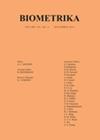用于频谱密度估计的去偏差韦尔奇方法
IF 2.8
2区 数学
Q2 BIOLOGY
引用次数: 0
摘要
摘要 韦尔奇方法提供了一种统计上一致的功率谱密度估算器。这是通过对时间序列的重叠片段计算出的周期图求取平均值来实现的。对于有限长度的时间序列,虽然估计器的方差会随着分段数的增加而减小,但估计器的偏差幅度却会增大:在设定分段数时,偏差与方差之间会产生权衡。为了解决这个问题,我们提供了一种新的韦尔奇去偏方法,这种方法既能保持计算复杂性和渐进一致性,又能改善有限样本性能。该方法给出了具有有限四阶矩和绝对收敛四阶累积函数的四阶静止过程的理论结果。通过数值模拟和实际数据的应用,证明了偏差的显著减少。我们的估计器还允许频率上的不规则间隔,并演示了如何将其用于信号压缩和进一步降低方差。本研究的相关代码采用 R 和 python 语言编写。本文章由计算机程序翻译,如有差异,请以英文原文为准。
Debiasing Welch’s Method for Spectral Density Estimation
Summary Welch’s method provides an estimator of the power spectral density that is statistically consistent. This is achieved by averaging over periodograms calculated from overlapping segments of a time series. For a finite length time series, while the variance of the estimator decreases as the number of segments increase, the magnitude of the estimator’s bias increases: a bias-variance trade-off ensues when setting the segment number. We address this issue by providing a novel method for debiasing Welch’s method which maintains the computational complexity and asymptotic consistency, and leads to improved finite-sample performance. Theoretical results are given for fourth-order stationary processes with finite fourth-order moments and absolutely convergent fourth-order cumulant function. The significant bias reduction is demonstrated with numerical simulation and an application to real-world data. Our estimator also permits irregular spacing over frequency and we demonstrate how this may be employed for signal compression and further variance reduction. Code accompanying this work is available in R and python.
求助全文
通过发布文献求助,成功后即可免费获取论文全文。
去求助
来源期刊

Biometrika
生物-生物学
CiteScore
5.50
自引率
3.70%
发文量
56
审稿时长
6-12 weeks
期刊介绍:
Biometrika is primarily a journal of statistics in which emphasis is placed on papers containing original theoretical contributions of direct or potential value in applications. From time to time, papers in bordering fields are also published.
 求助内容:
求助内容: 应助结果提醒方式:
应助结果提醒方式:


